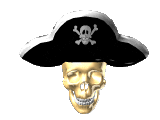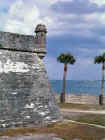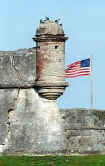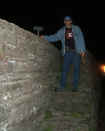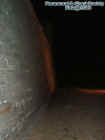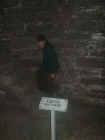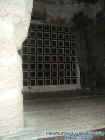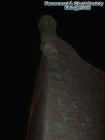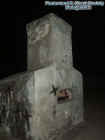|
|
||
|
Between the years 1672 and 1695 the Spanish Constructed one of the largest coquina stone forts in the country. The Spanish felt a need to build this fort when Sir Francis Drake a pirate burnt the down St. Augustine in 1586 with his fleet of 20 ships and 2000 pirates. To the north of St. Augustine what is known as Jacksonville the English were colonizing very quickly so Queen Marina of Spain authorized to have the stone fort built to protect the small garrison of St. Augustine. Slaves from Africa and Indians built it for the Spanish as it took 23 years of hard labor. The fort built out of Coquina which is a shell stone was quarried from Anastasia Island where the lighthouse sits today. The fort was built to withstand attacks as since it as built it never had been conquered despite attacks from James Oglethorpe in 1740 whose cannon balls had no effect on the fort. The Coquina absorbed cannon balls rather then crumbling perhaps this is why the fort was never conquered. The fort allowed Spain to retain Florida for many years. Although many different flags have flown atop of the fort including the Spanish (1695 - 1763) the British (1763 - 1784), the Spanish again (1784 - 1821), the United States of America (1821 - 1861), the Confederate States of America (1861 - March of 1862), and finally the United States of America again (1862 - 1900) the fort was always taken by means of military agreements or treaties but never bloodshed. From the year 1565 there were 9 other forts that were built by the Spanish Castillo being the 10th. All the other forts previously were built of wood so some of them were burnt down unlike this stone giant. The coquina for the fort was brought over on ferries and stone masons from Havana produced giant blocks. They made mortar to bond the blocks together by baking oyster shells in kilns until they fell apart into a fine white power called lime. They would mix the lime with water and sand which would produce the mortar. Then they would apply it between the blocks creating a cement like bonding which holds the coquina together even to this day. One of the first battles this fort suffered was in 1702 when a man by the name of Charles Town from Carolina started a siege to the city of St. Augustine. Over 1200 people ran into the fort to take shelter. The people remained inside the fort for two months. Eventually the siege ended when a relief fleet from Havana trapped the British Ships within the bay. When they captured the British ships they forced the men to burn their ship and they withdrew. Upon withdrawing they burnt down St. Augustine in retaliation. After this incident in 1702 the forts interior was reconstructed. The rooms in the fort were enlarged and increased out into the courtyard so they would be deeper. Vaulted arch ceilings were added to make the rooms bombproof which would protect the food and weapons. These vaulted ceilings allowed the Spanish to install heavy garrison guns to be put all the way around the forts perimeter also called the gun deck. Originally guns only existed on the four bastion towers on each corner making it not a very offensive fort. When the gun decks were added the Spanish could then attack from all ends. The rise of the walls were brought from 26 feet to 33 feet in height. At that time The Spanish started to build coquina walls around the city which would protect the structures and homes of the settlers. One entrance was the City Gates which at the time was called the Land gate. The other entrance had a guardhouse installed which would snuff out any unwanted visitors. Going back to 1740 the English wanted to establish Florida because Georgia was a disputed territory. James Edward Oglethorpe for 38 days laid siege onto the fort. Hoping to capture the fort would mean a British victory but his cannons being shot from batteries on Anastasia Island had to effect on the fort. The governor at the time Manuel De Montiana did not surrender. The fort fought back against various vessels in the Matanzas inlet and so did Spanish Ships to return with more supplies. When the supply ships returned the British had given up and hurricane season was also near. So despite the British taking over Fort Mose, Fort San Diego, Fort Picolotta they could not taken over this strong hold so again Castillo lived up to its name. During the Seven Years War the British had taken over Havana and when the war ended The Treaty of Parish was put into effect which gave the British possession of St. Augustine and all of Florida. The British in return gave Havana back to Spain. They made St. Augustine the Capital of East Florida and split the state into two colonies. They were the east and west. The British did not change much of the fort but they changed the name to Fort St. Marks. At the time the British held most of the east coast. However this would not last long as the 13 colonies up north were starting to rebel which then the American Revolution had started. In 1775 the British made some changes to upgrade the fort to protect themselves against rebellions. They repaired the gates and well, increased housing within the Fort for troops and made it into a regimental headquarters. They started to use it for a few patriots that had been captured in the war. When the war broke out in 1779 Spain declared war during the revolution on Britain and the Spanish battled from New Orleans to take over areas like Mobile and Pensacola. They were working there way back to St. Augustine but before they were able to take it back the revolution ended and the treaty settlement gave the Spanish back Florida including St. Augustine. In 1784 the named was changed back to Castillo De San Marcos. Upon there return they found that many run away slaves escaped into Florida along with ruffians and scoundrels who called Florida their home base. The British kept the fort very well with new reinforcements of new defenses and weaponry the fort remained a very major strong hold almost a century later still. Piracy was still a big issue in the 1700s and a pirate attack took place on Anastasia Island. The leader one one of them pirate groups had fallen by the name of Thomas Bell. The Spanish had shown his body in the gallows of the Castillo to set an example of what would happen if pirates attacked St. Augustine. Eventually in 1821 after many pressures from the United States the Spanish turned over the city and fort. Spain ceded Florida to the United States. The Americans now had control of the fort so they changed then name to Fort Marion which was in honor of General Francis Marion of the Revolutionary War. The old store rooms which had barred windows and heavy doors were converted to prison cells. The army engineers turned the east moat into a water battery for coastal defense and improved the hill surrounding the fort. When the Americans took over the fort they jailed many Seminole Indians here one of the most well known is Osceola in 1837. Then in the 1870s and 1880s when the Manifest Destiny took place many other Indian tribes were imprisoned here such as the Cheyenne, Comanche, Arapahoe, and Apache Indians captured out west. But taking a step back in 1845 Florida had became a state to the Union and remained a state to 1860 when instead Florida became one of the Confederate States Of America. During the civil war the fort was under Union control but was handed back in 1861 after the Union commander took all of its supplies giving the confederates an empty coquina shell which would not pose any threat to the Union. Then a year later during the Civil War despite it was given to the Confederates after the USS Wabash a Union gunboat took the city and fort over. No shots were fired but since the area was evacuated and the local confederates inhabited it they did surrender so they town would not be destroyed from attack. After the civil war however the fort did become a prison. In 1875 the first group of Plain Indians were held at Fort Marion. There were 62 prisoners taken to various cells within the fort. The Indian tribes were Kiowa, Comanche's, Araphoes, Cheyenne and even one Caddo. The famous Indian leaders captured were Black Horse of the Comanche, Gray Beard from the Minimic tribe which was killed while on the way to the fort, Heap of Birds and medicine Water from the Cheyenne, Lone Wolf, Woman's Heart and White Horse of the Kiowa's. Richard H. Pratt escorted the Indians to Florida and they were held roughly a few years for their crimes. Then in 1898 the fort again was used as a prison. Almost 200 court marshaled deserters from the American Army were imprisoned here from the Spanish American War. Then by 1924 the fort was removed as an active base and was made into a national monument serving 205 years of battles, history and six flags. In 1933 the Fort was restored under the National Park Service and maintained. Then in 1942 it was renamed Fort Castillo the original name from congress. A total of 25 acres existed including the Fort itself and a parking lot was laid out. At one time the moat was filled with water. But today the deep trenches are dry and drained. A old Kiln sits fairly close to the fort as well. Many rumors of the fort being haunted over the years seem to be very consistent. One of our investigators seen a ghostly guard up in the tower and years early I talked to a person who had also seen a cloaked figured looking out from that same tower. So we definitely know there is a ghostly soldier who seems to haunt the lookout tower. Some who visit the fort say they have heard the Battle Echoes by placing their ear to the wall. They said they can hear cannon fires, yelling, screams and battling taking place. Then we have another story of a ghostly young soldier who is often seen leaning on one of the outside walls facing the bay just after sundown. Then some have seen a Spanish guard who smells still of Garlic and Sweat some say he faced death protecting the fort. While others have seen the ghost of many Native Americans who were imprisoned here. The fort today remains one of the most active and haunted places in St. Augustine as it has stood for over 300 years an of course with that much tragedy it has watched it is truly a paranormal wonder. This is a place where many of the ghost seem to be residual and the ghost that walk its dark halls and along its walls are as old as when the Spain claimed Florida for themselves. © By Rick-AngelOfThyNight In accordance with Title 17 U.S.C. Section 107, any copyrighted work in this message is being distributed under fair use without profit or payment to those who have expressed a prior interest in receiving the included information for non-profit research and educational or criticism purposes only. Notwithstanding the provisions of sections 106 and 106A, the fair use of a copyrighted work, including such use by reproduction in copies or phone records or by any other means specified by that section, for purposes such as criticism, comment, news reporting, teaching (including multiple copies for classroom use), scholarship, or research, is not an infringement. Anotherwards a few photos are borrowed we do not make any profit off pictures mainly they are used for historical, criticism, theories and other educational purposes therefore we can use them as long as we do not claim them as our own or get paid for those photos specifically.
|
||
|
|
|


